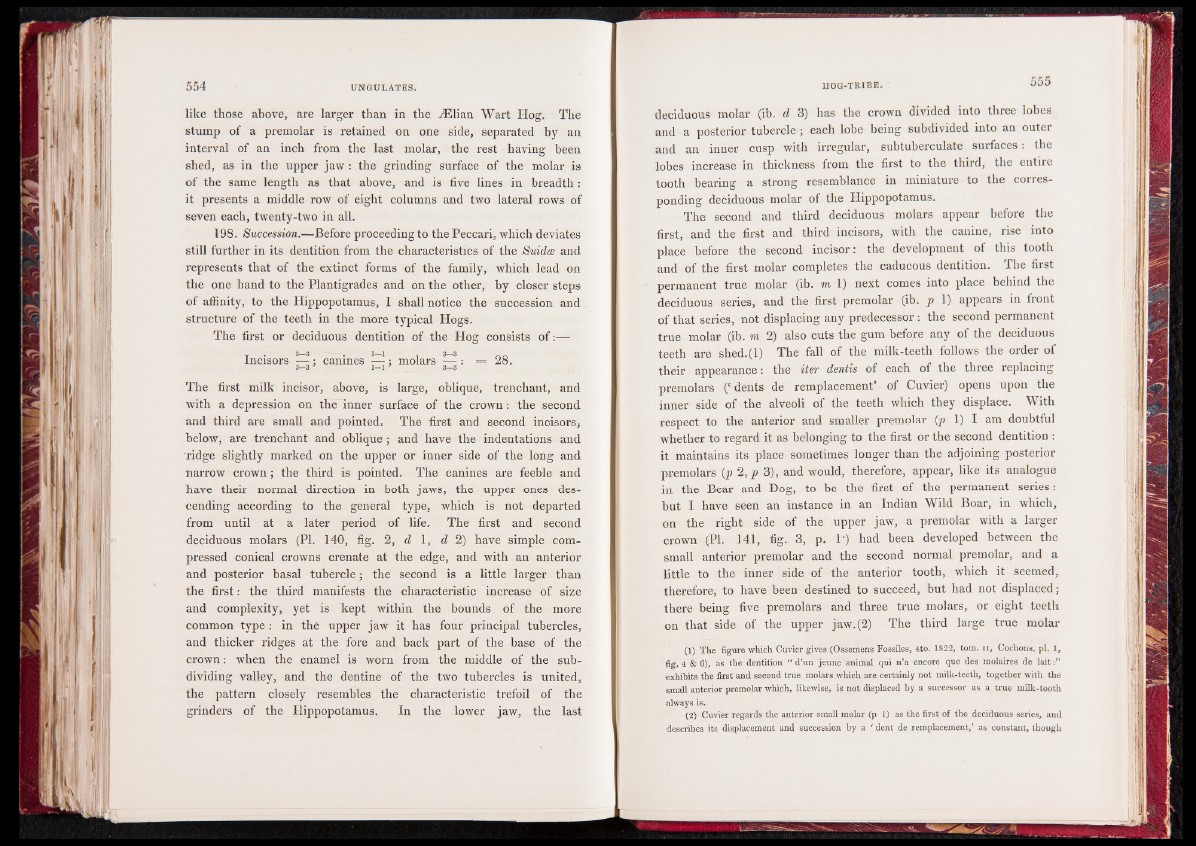
like those above, are larger than in the vElian Wart Hog. The
stump of a premolar is retained on one side, separated by an
interval of an inch from the last molar, the rest having been
shed, as in the upper jaw : the grinding surface of the molar is
of the same length as that above, and is five lines in breadth :
it presents a middle row of eight columns and two lateral rows of
seven each, twenty-two in all.
198. Succession.—Before proceeding to the Peccari, which deviates
still further in its dentition from the characteristics of the Suidee and
represents that of the extinct forms of the family, which lead on
the one hand to the Plantigrades and on the other, by closer steps
of affinity, to the Hippopotamus, I shall notice the succession and
structure of the teeth in the more typical Hogs.
The first or deciduous dentition of the Hog consists of
Incisors B ; canines — ; molars “ : 28.
The first milk incisor, above, is large, oblique, trenchant, and
with a depression on the inner surface of the crown: the second
and third are small and pointed. The first and second incisors,
below, are trenchant and oblique; and have the indentations and
ridge slightly marked on the upper or inner side of the long and
narrow crown; the third is pointed. The canines are feeble and
have their normal direction in both jaws, the upper ones descending
according to the general type, which is not departed
from until at a later period of life. The first and second
deciduous molars (PI. 140, fig. 2, d 1, d 2) have simple compressed
conical crowns crenate at the edge, and with an anterior
and posterior basal tubercle; the second is a little larger than
the first: the third manifests the characteristic increase of size
and complexity, yet is kept within the bounds of the more
common type : in thè upper jaw it has four principal tubercles,
and thicker ridges at the fore and back part of the base of the
crown: when the enamel is worn from the middle of the subdividing
valley, and the dentine of the two tubercles is united,
the pattern closely resembles the characteristic trefoil of the
grinders of the Hippopotamus. In the lower jaw, the last
deciduous molar (ib. d 3) has the crown divided into three lobes
and a posterior tubercle ; each lobe being subdivided into an outer
and an inner cusp with irregular, subtuberculate surfaces: the
lobes increase in thickness from the first to the third, the entire
tooth bearing a strong resemblance in miniature to the corresponding
deciduous molar of the Hippopotamus.
The second and third deciduous molars appear before the
first, and the first and third incisors, with the canine, rise into
place before the second incisor: the development of this tooth
and of the first molar completes the caducous dentition. The first
permanent true molar (ib. m 1) next comes into place behind the
deciduous series, and the first premolar (ib. p 1) appears in front
of that series, not displacing any predecessor | the second permanent
true molar (ib. m 2) also cuts the gum before any of the deciduous
teeth are shed.(l) The fall of the milk-teeth follows the order of
their appearance: the iter dentis of each of the three replacing
premolars (‘ dents de remplacement’ of Cuvier) opens upon the
inner side of the alveoli of the teeth which they displace. With
respect to the anterior and smaller premolar (p 1) I am doubtful
whether to regard it as belonging to the first or the second dentition :
it maintains its place sometimes longer than the adjoining posterior
premolars (p 2, p 3), and would, therefore, appear, like its analogue
in the Bear and Dog, to be the first of the permanent series:
but I have seen an instance in an Indian Wild Boar, in which,
on the right side of the upper jaw, a premolar with a larger
crown (PI. 141, fig. 3, p. 1') had been developed between the
small anterior premolar and the second normal premolar, and a
little to the inner side of the anterior tooth, which it seemed,
therefore, to have been destined to succeed, but had not displaced;
there being five premolars and three true molars, or eight teeth
on that side of the .upper jaw.(2) The third large true molar
(1) The figure which Cuvier gives (Ossemens Fossiles, 4to. 1822, tom. n . Cochons, pi. 1,
fig. 4 & 6), as the dentition “ d’un jeune animal qui n’a encore que des molaires de lait
exhibits the first and second true molars which are certainly not milk-teeth, together with the
small anterior premolar which, likewise, is not displaced by a successor as a true milk-tooth
always is.
(2) Cuvier regards the anterior small molar (p 1) as the first of the deciduous series, and
describes its displacement and succession by a ' dent de remplacement,’ as constant, though